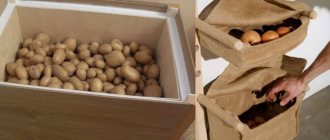It’s not enough just to harvest a good potato harvest; it needs to be stored properly. The best conditions for this are dark, cool rooms, where the thermometer shows from +3 to +6 °C and air humidity is from 85 to 95%. For owners of a private house, the ideal place would be a cellar or underground, or, in extreme cases, a dry basement. In apartments, space is limited, so storage is carried out on the balcony, in the storage room or in the entrance corridors. Can potatoes be stored in the refrigerator? If the harvest is larger, then we do not recommend doing this. If there is not much of it, then this is a completely acceptable option.
Can you keep potatoes in the refrigerator?
Refrigerators maintain optimal temperatures for the preservation of most common varieties. True, there is not much space in it, but the potato reserves inside can be constantly replenished as they are used. In addition, already peeled raw potatoes can be stored exclusively in the depths; in warm conditions they will quickly darken. Many housewives make preparations from potatoes for the winter, cutting them into slices, processing and freezing them.
What determines the keeping quality of potatoes?
The preservation of vegetables in winter is largely determined by factors such as their growing conditions, the quality of the fruit, and the crop variety.
Cultivation conditions
The keeping quality of tubers depends on their growing conditions, so it is worth understanding several important nuances that negatively affect the shelf life of vegetables:
- Cool summers with frequent rains, excessive soil moisture during the growing season.
- Grows on loamy and lowland soils.
- A large amount of nitrogen fertilizers when fertilizing, and the lack of the proper amount of potassium.
- Neglect of disease prevention and failure to take appropriate measures when suspicious symptoms are detected.
- Untimely late harvesting of the bed.
When growing potatoes for storage, it is worth considering many details, and how to take care of the future harvest so that there are no problems later due to inattention and negligence.
Variety
The correct choice of variety is of great importance when storing potatoes. It is a well-known fact that early varieties are unsuitable for long-term storage for the winter, since their shelf life expires in mid-autumn, so it is better to give preference to late or mid-season varieties. The following potato varieties have good keeping quality:
- Bryansk red;
- Zdabytak;
- Lady Rosetta;
- Atlant;
- Stonefly;
- Manitou;
- Picasso;
- Oleva;
- Folva.
A suitable variety can be identified by its thick skin, high resistance to fungal diseases, and the absence of rot and weight loss, which are part of the genetic characteristics of the variety.
Tuber quality
The decisive factor when planting potatoes for the winter is the quality of the tubers. In order to preserve the harvest as much as possible, special requirements are placed on them during sorting:
- inadmissibility of damage, dense, whole peel;
- uniformity of color and shape of all specimens;
- absence of significant dryness, phlegm on tubers and sprouted parts;
- absence of various defects, signs of disease and pests, and foreign odors.
Tubers that do not meet the requirements are subject to initial use or disposal.
It is worth considering that even one spoiled tuber can negatively affect other vegetables and cause them to become infected and rot.
Storing the potato harvest is a set of measures that is aimed at combating the loss of stocks of tasty and healthy vegetables. Proper organization will help preserve the organoleptic qualities and presentation of tubers with minimal loss of weight.
Why it is not recommended to keep potato tubers in the refrigerator
Even if you still have a large old refrigerator, experienced gardeners do not recommend storing large volumes of crops in it. Why can't you do this? There are several reasons for this.
- If stored for a long time in the refrigerator, where the space is enclosed and the humidity level is sometimes not exactly what potatoes like, the fruits may rot. First, the peel begins to get wet, and rot from it quickly spreads to other tubers, making them unsuitable for eating.
- In the refrigerator, potatoes begin to sprout much faster. This has a bad effect on its taste.
Reference. If the temperature in potato storage remains below +1...+2 °C for a long time, then the process of starch decomposition into simple sugar starts in the fruit. This is why frozen potatoes have a sweetish taste.
It is convenient to place a small amount of harvest in the refrigerator, which is regularly taken out and used. Therefore, the probability of its damage is quite small.
Why do potatoes turn dark and spoil after peeling?
After you peel the potatoes, after a few hours they will begin to turn black. The reason for this is the substance it contains called tyrosine. Initially, it has a transparent color, but when it interacts with air, oxidation occurs, which is why the color of the vegetable changes.
Store-bought potatoes darken more slowly because they are treated with various chemicals. A self-grown vegetable will begin to change color within 1.5-2 hours. Using this method, you can check potatoes for the presence of harmful substances in them. Boiled potatoes do not change color at all, since tyrosine is destroyed during heat treatment.
The color change does not affect the taste and quality of the potato, so even after the appearance of black color it can be consumed.
Pros and cons of storing potatoes in the refrigerator
There are certainly a number of advantages to storing tubers in a refrigerator:
- Temperature stability. The refrigerator is perhaps one of the few places that can boast a constant temperature level. Unless, of course, there is a breakdown or power failure.
- Inside the refrigerator it is quite humid and there is no lighting, which is important for normal storage of crops.
- When cooking, it is convenient to have all the vegetables at hand, including potatoes.
- Potatoes in the refrigerator retain their taste and freshness for a long time.
Advice. You can save the most delicious harvest if you place it underground, after sorting it into wooden boxes.
Thermal box
Potatoes are famous not only for their ease of cultivation, but also for their beneficial properties, which are preserved only with proper storage. Everyone knows that during cooling some of them may be lost.
That is why some people consider the refrigerator not the best place to store crops. There are a number of other factors that oppose the refrigerated placement method:
- Inside older models of refrigerators, the temperature can be from 0 to +6 °C at the same time. The deeper, the colder. And at +1 °C the starch in potatoes already begins to disintegrate. Because of this, the tubers acquire a sweet taste and fall apart when cooked.
- If we are not talking about appliances with the No Frost system, then in conventional refrigerators there is no air movement. Due to the tightness of the door, oxygen also does not penetrate inside. Therefore, the fruits rot quite quickly.
- Potatoes that are too dirty must be cleaned before placing them so as not to stain the refrigerator. This takes extra time. It is impossible to put it in polyethylene to avoid contact with the surface of the shelves; it will certainly rot in it.
- Household refrigerators are too small to store large quantities of tubers. The maximum you can place inside is 12 kg of potatoes.
Carefully! If your potatoes have acquired a green tint, you should absolutely not eat them. The appearance of greenery is a sign that the vegetable produces solanine, which is harmful and hazardous to health. It is also better to throw away fruits that have turned black and have lost their elasticity.
How to keep it from darkening
Discoloration of freshly peeled potatoes is not a sign of spoilage. This is a consequence of the interaction of amino acids and enzymes that react in air. The tubers simply lose their attractive appearance. If the potatoes have been lying without water for several minutes, you just need to cut off the dark spots and cook.
You should not leave potatoes without water for a long time - along with darkening, a gradual decomposition of amino acids occurs, which threatens a deterioration in taste, loss of nutrients and spoilage.
Why do potatoes darken and lose their taste?
Potato skins protect the root crop from air. After cleaning, the process of oxidation of the substances contained in the tubers begins.
Blackening is caused by two components of the composition:
- tyrosinase;
- tyrosine
The amino acid tyrosine, initially colorless, becomes colored when exposed to air. The enzyme tyrosinase increases the rate of oxidation. Due to these components, potatoes turn bluish-brown when exposed to air. The color changes most quickly in root crops that received a lot of nitrogen fertilizers during growth. Such potatoes can darken in a few minutes.
How to determine the suitability of a vegetable
Before you start cooking stale potatoes, you need to find out whether they can be used. How can you tell if tubers have gone bad? Signs of spoilage of a product stored in water:
- Water. The liquid becomes cloudy, gas bubbles form in it, and fermentation occurs.
- Potato. The tubers become limp and slippery. The top layer separates when pressed or retains fingerprints.
- Smell. The natural smell of raw potatoes gives way to an unpleasant one, and the smell of fermentation and rotting appears.
If the product has deteriorated, it is useless to remove the top softened layer - the potatoes have already lost their taste.
If root vegetables have been stored dry for a long time, including in the refrigerator, signs of spoilage are blackness on the surface, drying out, and deformation. If you remove the dried crust and cook the rest, the dish will not taste good.
You can eat aged potatoes if they have retained their natural aroma, color and density.
Rules for storing potatoes in the refrigerator
In Russia there is a GOST that regulates almost any action with food products, even the storage of potatoes.
Potato storage
The standard we need is called “Fresh food potatoes. Storage Guide." According to his recommendations, potatoes, including seed ones, should be stored as follows, no matter in summer or winter:
- Place fruits in bags, boxes, on pallets or in bulk on the floor.
- Ensure normal ventilation indoors, as tubers emit heat and carbon dioxide.
- Create complete darkness, daylight should not penetrate inside.
- The lower air temperature should be +3 °C.
- Humidity should be maintained at 85-95%.
If you nevertheless choose a refrigerator as a place to store your harvest, then you should follow a few simple rules:
- Place potatoes in a special compartment for vegetables, where the optimum temperature is maintained. If the refrigerator model allows it, then set the temperature to +3...+6 °C.
- Potatoes in the vegetable department should not have any neighbors other than beets. It happily absorbs the moisture released by the tubers, which prevents the appearance of rot. Some gardeners add mint sprigs or a green apple instead of beets. Other vegetables should definitely not be stored nearby.
- If your vegetables are dirty enough, you don't need to put them in a plastic bag. Either rinse them thoroughly and dry them, or put them in a paper bag. Otherwise, the tubers will suffocate, begin to get wet and rot.
- Do not put wet fruits in the refrigerator; they must be completely dry. If there is no suitable place to store vegetables, the right thing to do is to buy them as needed with a small supply.
Storing potatoes in factories
In large factories for the production of chips and other dried raw materials, raw peeled potatoes have to be stored in huge quantities. Here the vegetable is stored in freezers at -30℃. Under such conditions, the product can be stored indefinitely. A thin layer of peel is removed from vegetables, and washed, unpeeled potatoes are sometimes used for chips. After all stages of preparation, the root vegetables are cut into cubes of the required size and placed in bags.
The air is then sucked out of the bags and placed in freezers. With shock freezing, root vegetables are not only stored for a long time, but also retain all their beneficial vitamins and minerals. Large food production plants also practice storing potatoes in bags filled with inert gas. It helps preserve the freshness of root vegetables for 2-3 months, unfrozen.
Shelf life of fresh potatoes and how to keep them in the refrigerator for as long as possible
The shelf life of unpeeled fresh potatoes largely depends on storage conditions and where it is sold. But the variety also plays an important role in how long and how well your potatoes will be stored. Some varieties like the cold. Others, on the contrary, like it when it’s warmer. All these varietal preferences also need to be taken into account.
Freshly dug fruits should not be placed in the refrigerator. There are microcracks on their skin that need to dry out. Therefore, all tubers are sent to a warm place for ripening for about 10-14 days.
So, how long do potatoes last? Depending on the ripening period, it also has its own storage characteristics in the refrigerator:
- Young potatoes can only last about three weeks without losing their taste.
- Middle and late varieties will last from 4 to 5 months.
- Ripe potatoes can be stored for up to 7-8 months.
On an industrial scale, the fruits are placed in special refrigeration chambers, but purchasing them for the home is too expensive - their price starts from 50 thousand rubles.
Important! It happens that when the potatoes have finished blooming, the tubers in the ground begin to rot. As a rule, the reason is that the late blight pathogen gets onto them from the tops. There is a way out of this situation - mow the tops two weeks before harvest so that the potatoes can ripen normally. And do not forget that after digging, diseased and damaged tubers should be put aside, or better yet, thrown out altogether, but under no circumstances should they be stored with the rest of the potatoes, otherwise they will all rot.
Preparation
We offer you step-by-step instructions for the ideal preparation for storing potatoes.
Not all of its stages are mandatory, but if you want to preserve the harvest for as long as possible, it is advisable to adhere to it:
- The harvest is sorted, rotten or sprouted fruits are removed.
- The tubers are washed in cold water and disinfected in a weak solution of potassium permanganate (disinfection is not necessary, but it helps protect against rot).
- The potatoes are thoroughly dried and wiped (if they were washed before).
- Everything is put into a paper bag. It is strictly forbidden to use plastic containers. If you don’t have one, you can use paper towels or special napkins as a layer.
- Several sprigs of mint are placed in the intertuberous space.
Storage process
Almost every refrigerator has special drawers for storing vegetables. You need to place the prepared potatoes there. If there is no such compartment, then place the tubers on the shelves, but not too close to the walls and not under the freezer.
On a note. If the refrigerator does not have a special ventilation system, then place beets or apples next to the tubers; they will restrain the process of rot formation and reduce the rate of potato germination.
It is strictly forbidden to eat those fruits that have lost their shape, become flabby and have greens in the peel and pulp.
If the green color only slightly touches the skin, then it can be cut off. But if the flesh also turns green, then throw away the fruit without hesitation.
Shelf life of raw potatoes in the refrigerator
The refrigerator, even though the temperature in it is the same as in the underground, is not close to it in terms of the quality of crop storage. And this is natural, because refrigerators were made for short-term storage of products. Therefore, it is best to store potatoes there for no more than a week. If you're lucky, it will last much longer, but the taste and structure of the tuber can change greatly.
Which varieties store best?
The shelf life of the crop depends on many factors, the most often influenced by soil and climatic conditions and the microclimate on the site during the growing period of the vegetable.
Did you know? The potato became the prototype for a toy popular in the late 1940s called Mr. Potato Head is a potato tuber with eyes, arms, hat, boots and other accessories.
The main condition for long-term storage of tubers is a dense and intact peel, which is a protective barrier for the pulp from damage by fungi and bacteria. In addition, varieties that love moisture are not able to be stored for a long time. Due to the abundant accumulation of water, the pulp becomes watery, which over time starts the process of rotting.
The varieties that are more resistant to diseases and pests have better shelf life, so if the variety is not resistant to them, over time both individual tubers and the entire crop will die within a couple of months after harvest.
Late potatoes with a long growing season, characterized by natural resistance to weather conditions and biotic factors, are better stored.
Among them, the following varieties are considered popular and in demand among gardeners:
- Picasso;
- Crane;
- Asterix;
- Blue;
- Lorch;
- Atlant;
- Stonefly.
Storing peeled potatoes in the refrigerator
It often happens that you need to peel potatoes and store them for some time until cooking. For example, before guests arrive, you can prepare it in advance, so as not to waste time on it later. But if you leave the tubers on the table, they will immediately turn black due to the presence of a specific substance in them - tyrosine. Therefore, they are placed in a pan and completely filled with water. In the cold of a refrigerator, such potatoes can last in their original form for 24 hours, but on the kitchen table - only about 4 hours.
But housewives have found a way to increase the shelf life of peeled fruits to 4 days if they continue to store them in the refrigerator, change the water daily and add a couple of slices of lemon to it.
Reference. A dissolved aspirin tablet can replace lemon without reducing the quality of the fruit or its shelf life.
Potatoes can also lie without water if you put the well-dried tuber in a plastic bag, pre-lubricate it with oil and prevent air from getting inside. The fruits will quietly lie in the refrigerator for 3-4 days. If you exclude the greasing stage, the potatoes will last for 1 day.
How to store peeled potatoes at home
There are several ways to preserve taste, color, and usefulness in vegetables after cleaning at home. They are quite well known and simple:
- Cold water. You can place the peeled tubers in cold water. But in this way the vegetable will be stored for no more than 4 hours. This is due to the fact that peeled potatoes lose useful substances in water: organic acids, microelements, vitamins.
- Food bags. After peeling and washing the potatoes, place them in a plastic bag and squeeze out as much air as possible. Place the bag in the refrigerator. This method will preserve the product for a day.
- Freezing. Place the peeled vegetable in a plastic bag in the freezer. If the preparation is intended for soup or frying, the tubers should be cut accordingly before freezing.
- Boiling water. Scald the finished semi-finished product with boiling water. The top layer of each potato will be protected from browning by high temperature treatment. This product can be stored in the refrigerator for no more than a day.
Related article: Spices for potatoes - options for boiling, frying and stewing
Tip of the day
Place the container with water and potatoes in the refrigerator - the storage time will increase to 24 hours.
Storing boiled potatoes in the refrigerator
Any potato dishes can be refrigerated for several days. For example, boiled or fried potatoes will stay there for up to 5 days. Although experts do not recommend eating anything that has already been in the refrigerator for more than two days. If you are bothered by the smell coming from the potatoes, throw them away immediately.
If you prepared mashed potatoes with milk, they will last no longer than two days in the refrigerator. If you use water instead of milk, the period will increase by one more day.
Storage time dictates the method
The storage time of the semi-finished product affects the choice of method. To preserve the maximum taste and nutritional properties of the product, you should follow simple rules:
- For a few hours. If the cooking time is delayed by 3-4 hours, feel free to peel the required amount of vegetable and immerse it in a bowl of cold water.
- For the night. When you plan to prepare a potato dish for breakfast, fill the peeled tubers with cold water in the evening and place in the refrigerator until the morning.
- For a day. Place the prepared product in the refrigerator using a bag or bowl of water. It is necessary to cover all the potatoes with water or first check the tightness of the bag. You can also pour boiling water over the tubers and place them in the refrigerator after cooling.
- For a long time. If you plan to store the peeled vegetable for a long time, then the freezing method is ideal. And when cooking, do not defrost it, but immediately put it in boiling water or hot fat. It is not recommended to use a microwave oven for defrosting.
Other options for storing potatoes in an apartment
Residents of private households do not have to rack their brains when choosing a place to store vegetables. Usually this is a cellar, basement or basement. City apartment dwellers were less fortunate. As a rule, they only have a storage room and a balcony at their disposal.
An insulated loggia is best suited for potato wintering. The air temperature in it is higher, and changes occur less frequently. Wooden boxes without gaps are made for tubers. It is necessary to further insulate the structure by constructing double walls and filling the space between them (usually 8 to 10 cm) with sawdust, foam plastic or other heat-retaining material. Wooden lining or plywood are suitable for construction; before starting operation, you need to coat the surface inside and outside with a special disinfectant composition. To increase moisture resistance, it is advisable to paint the outer walls of the box or cover it with leftover linoleum. If it is lined with felt, it will also provide additional warmth.
If the loggia or balcony is not insulated, then proper storage is much more difficult to organize. First of all, the design of the box will be different - a crate should be placed on the bottom, on which the potatoes will be poured. The side walls are equipped with an air vent, and a special thermal lamp is placed inside. It will regulate the temperature of the space. As you know, potatoes quickly turn green under light rays. Therefore, it needs to be covered with thick black cloth.
Mesh bags are suitable for storing not too large volumes of crops. The tubers breathe in them, they are convenient to transport and you can immediately see if there are damaged or rotten potatoes.
To overwinter potatoes in the pantry, prepare cardboard boxes in advance, make a few holes on the sides for ventilation, and cover the top with a dark rag or cardboard to prevent exposure to light.
Sometimes you can still find old houses, in the entrances of which you can see large boxes with locks screwed to the floor, where potatoes are stored. The box is insulated and carefully closed. The main thing is that the neighbors do not mind and do not suffer from a craving for marginal behavior.
Whatever storage method you choose, you must sort all the tubers, setting aside damaged or sprouting ones. If the fruit is still strong, but mechanical damage is clearly visible on the skin, then you can leave it in the refrigerator for a couple of days for use as food. But you definitely can’t put it in a common box; it will ruin all the other tubers. You should also not send wet vegetables for storage, they will certainly rot.
So, even if you don't have a special cellar with huge supplies of potatoes, this doesn't stop you from buying them as needed and storing them in the refrigerator for a week.
How to make bulk storage with your own hands?
A bulk cellar is an excellent solution if you grow vegetables or fruits in large quantities. It is created using a special technology, so a favorable temperature will be maintained there.
To begin, choose the right location. The location for the cellar should be dry and located on a hill. The entrance inside is located on the north side. Choose your material wisely.
Best suited:
- tree;
- brick;
- slate.
After choosing the material, we begin construction. First you should clear the area and remove the top layer of soil. Then we make some kind of foundation out of clay. Next, pour crushed stone and fill everything with bitumen on top. When everything is dry, we begin building the walls. It's worth starting with the frame.
After its construction, we line the box with wood and reinforce it with brick. Before making a roof, it is necessary to carry out thermal insulation. Mineral insulation is suitable for this. After that, we cover the entire structure on top with a mixture of straw and clay.
The roof should be made of wooden beams, metal plates or concrete slabs. After completing all the work, fill the cellar with earth
Pay attention to the slope, it should be 45 degrees. Then the structure is again covered with roofing felt and covered with earth to a depth of 8-10 cm
This is where all the work ends, all that remains is to restore order inside.
To summarize: Mr. Summer Resident's recommendations for storing potatoes
Our portal https://mrdachnik.com advises:
- Carefully approach the process of sorting potatoes. Remove small fruits; the remaining tubers should be without visible damage or traces of germination.
- If you are going to store potatoes for a long time, then you need to set the temperature in the refrigerator correctly and put the vegetables in a special compartment. Pre-washed tubers will have a shorter shelf life and should be eaten first.
- It is strictly forbidden to stack potatoes where there is constant lighting. Under its influence, solanine, which is hazardous to health, will be formed in the tubers.
- If the refrigerator model is old without a temperature maintenance function, then the potatoes will last less in it.
- Do not put vegetables in plastic bags, they will rot there.
- Potatoes should not be placed next to carrots. On the contrary, she loves bags and retains her freshness in them longer. It is better to put beets with potatoes, which will absorb excess moisture.
Advice. A few apples or sprigs of mint placed between the vegetables will help slow down the process of fruit germination. Wormwood or rowan leaves will save you from rot; you will need 1 kg of them per 50 kg of potatoes. If you have the opportunity to pick fern leaves, then by all means do this and lay each new row of potatoes. This method greatly extends the shelf life.
- Green potatoes can cause food poisoning and should not be eaten. The same goes for wilted, shriveled tubers - they need to be thrown away.
- If your harvest is stored in a cellar at the dacha, then bring only the amount of vegetables you need so that the remaining tubers can last longer in more comfortable conditions for them.
How to prepare a cellar
The optimal constant temperature is 2-4°C. Constant humidity is also extremely important - 80-90% - as well as protection from water ingress.
The cleanliness of the cellar is of great importance, so it is pre-treated.
Treatment
All unnecessary things are thrown out of the cellar, garbage is removed, and the floor is swept. The shelves on which the boxes of potatoes will be stored are taken out into the sun and dried. They are then treated with antifungal drugs. The walls and ceiling are inspected for the presence of mouse and rat passages; if there are any, they are filled with cement. After this, the walls and ceiling are treated with lime.
After all these steps, the cellar is left open to dry for 3-4 days.
Preparing the storage container
If potatoes are stored in wooden boxes or pallets, they are inspected for damage and replaced with new ones if necessary. Then the boxes are cleaned of soil and other contaminants and washed with soapy water. After this they are dried in the sun.











